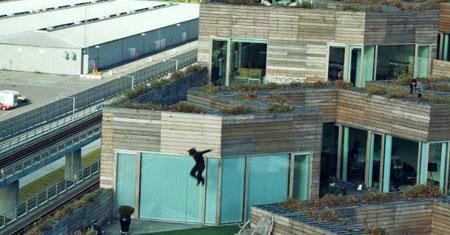The four tiny, nimble figures jumping and rolling down the Danish architect Bjarke Ingels' pioneering building, The Mountain, in the Orestad district just outside of Copenhagen, make an audacious and breathtaking picture.
"The beauty of parkour is that it's a form of urban ballet, it has a graceful quality in its own right. Therefore it becomes a very dynamic way to experience architecture, teaching you about urban space and urban life." Bjarke Ingels
For Kaspar Astrup Schröder, a multi-talented, self-taught filmmaker, musician and graphic artist, "My Playground" began as an out-of-pocket labour of love. Later, the Municipality of Copenhagen stepped in with funds.
Schröder spent a year tracking Copenhagen's Team JiYo, Denmark's leading parkour practitioners, who make the city their stage, leaping from high rooftops, somersaulting down Metro staircases or seeming to defy gravity as they soar between multi-storey carparks.
The film also features appearances by urban planners, local politicians, philosophers and, notably, Bjarke Ingels, founder of BIG Architects, who enthusiastically lets the young parkour artists loose on his buildings. Collaborating on the film was a real eye-opener for the successful Danish architect. Witnessing the acrobatic freerunners' impressive physical feats in urban spaces revealed new ways of animating and communicating architecture.
Set mainly in Copenhagen, the film also travels around the world, visiting urban acrobats in Japan, the United States, even China, where Team JiYo conquers the raw, still unfinished skeleton of BIG's expo-pavilion in Shanghai.
BIG's unfinished expo-pavilion in Shanghai
On Parkour, Urban Space and Film
Kaspar Astrup Schröder:
When I began doing these test shoots with the parkour teams, I started composing my pictures according to the buildings and the space, but with these guys moving in the space it became a totally different experience. This was an eye-opener to me, and it made the space much more alive and dynamic.
I filmed the top parkour team in Denmark, Team JiYo, jumping from rooftop to rooftop on The Mountain and did a short film. That's how Bjarke came on board. I gave him the film and he was like, "This is amazing, we have never seen our buildings in that perspective. I want to be more a part of what you're doing."
We began a discussion about perceiving space, exploiting space and how to show architecture in a film. It was a journey for everyone to make a film, not only about parkour but also about architecture, that didn't feel like a traditional film about architecture. So, for some people it's an architectural film, while others see it as a parkour film. I feel it's a good mix of both.
The film's opening sequence of The Mountain took half a day. I had one camera and I would make Team JiYo do things over and over again from all different angles. There are 78 apartments and I had to go around to each apartment to get permission for my performers to jump down on every platform.
I shot everything myself, so I was doing six takes from different angles, and by the last take the guys' and girls' knees were hurting, but they were really great. Creatively composing the images and visually thinking about how to compose scenes with the buildings was a lot of fun for me.
Bjarke Ingels, BIG Architects:
When Kaspar took those few hours of footage and put together a little teaser, it instantly became a classic and I started using it in all my lectures.
The film's main resonance comes from communicating on such a physical, intuitive level just by showing two guys climb up through The Mountain and jump back down again in a real, physical space.
Bjarke Ingels, BIG Architects
We started a dialogue with Kaspar about trying to engage with the architecture at all stages of its realisation – in the office, looking at the architectural models, going to the construction site and moving around the unfinished building and afterwards inhabiting the buildings once they are completed.
Whenever you create a building or an urban space, you contribute to the future life of the city. In doing so, you also contribute to the future of the culture and lifestyle of the people who live there. "My Playground" is, of course, a film about parkour, but it is also very much about the intricate link between public life and architecture. Showing architecture, not as some static art form, with the typical architectural photography focusing only on how light falls on a wall, but architecture as observing human life and attempting to accommodate it ...
The beauty of parkour is that it's a form of urban ballet, it has a graceful quality in its own right. Therefore it becomes a very dynamic way to experience architecture, teaching you about urban space and urban life. Architecture is an ongoing global dialogue. Using film, you can communicate ideas to people who do not have the luxury of travelling to Copenhagen or Shanghai and seeing the structures in person. In a way we learned from Kaspar, and we were able to capture some of the essence of the structure.
Excerpts from presentation on objectivecinema.net by Tara Farrell.



